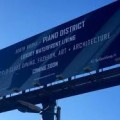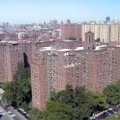 THE SOUTH BRONX ISN’T BURNING, ITS BEING EXPLOITED
THE SOUTH BRONX ISN’T BURNING, ITS BEING EXPLOITED
by David Lesch, Esq.
My family has been in the law practice business since 1965. Most, if not all of our legal work has done has been out of an office located across the street from the Bronx County Courthouse located on 161st Street and the Grand Concourse. Let’s just say my parents, both attorneys, have seen our South Bronx neighborhood during its good days, its bad days, and now, with its widespread transformation into a vibrant community, ready for its close up.
The days of the burning Bronx are long gone. Of course, that doesn’t mean that some won’t use the dark days suffered in the 1970’s as a showcase for their own self interests. Last week, a Bronx pop-up art show prompted backlash after a warehouse near my office was transformed into a “Back to the Future” circa 1970, when the Bronx was awash with crime and neglect.
The one night show called “Macabre Suite” had an A-list cast of celebrities including Carmelo Anthony, Naomi Campbell and Adrien Brody — not to mention high-ranking politicians. Both the Bronx Borough President Ruben Diaz, Jr. and the State Assembly Speaker Carl E. Heastie were in attendance.
So while the upscale guests were posting selfies and other photos throughout the night on Facebook and Twitter –some using the tagline “#thebronxisburning”– did anyone think about the ramifications of the $400 million plus residential and retail complex planned by Somerset Partners L.L.C. and the Chetrit Group (developers who helped organize the show)? Opponents have responded to an effort to rebrand the area with the hashtag, #whatpianodistrict.
Certainly the exhibit did not display the type of respect the Bronx truly deserved. As Melissa Mark-Viverito, a Democrat who is the City Council Speaker stated, “The South Bronx deserves respect — not a tasteless party that reduces Mott Haven and Port Morris to a sad caricature of urban blight”. I wholeheartedly agree. But I’ve also been thinking about what the future now holds for the South Bronx and my wonderful borough.
As the New York Times has noted, “The show has also fanned broader concerns about gentrification across the Bronx, at a time when a spate of development has brought amenities such as boutique hotels, new stores and a Trump-branded golf course.” Many Bronx residents have opposed the project suggesting that they will no longer be able to live in and around the area. Of course, the developers believe that the waterfront complex will produce jobs and other economic benefits for the area, including the opening of three restaurants, a coffee shop and an art gallery. But is the Bronx ready for the gentrification that is soon to follow?
Gentrification usually occurs after artists move into a neighborhood and fill the streets with galleries. Soon the artists are followed by the more affluent who are looking to be part of a new “happening.” But some who are in those neighborhoods are already worried about the coming changes. Along Jerome Avenue, an area of the South Bronx scheduled for residential rezoning, local workers earn little money while working in auto body shops and other blue-collar endeavors. If the shops are pushed out, where does that leave the workers?
History has shown that municipalities fail to get in front of gentrification so as to protect the community from displacement. By the time our politicians wake up, it’s already happened. We have the tools to preserve rent-restricted, affordable housing so as to neutralize the effects of gentrification.
New York City can do more to protect lifelong community residents from being displaced. How? By using aspects of the law to protect the poor and struggling from being pushed out. The City should acquire property in the area and make it available for low-income residents. For instance, using eminent domain and land banking to gain title to vacant and foreclosed homes, Mayor de Blasio can dedicate more residential units for the community. Important community assets and businesses can also be preserved through trusts. These “land trusts” can be instrumental in providing space for the displaced tenants.
While the waterfront residential and commercial complex, hotels, stores and golf course sound great, I believe we must use the law to protect those affected by the march of gentrification.
If people want to stay in their neighborhood, they should be able to. Especially, if they vividly remember the days of the Bronx on fire.
David Lesch is an attorney and host of ‘Today’s Verdict with David Lesch‘ on Bronxnet. Today”s Verdict airs Tuesday nights at 6:30pm, Cablevision channel 67, Fios channel 33.















Follow Us